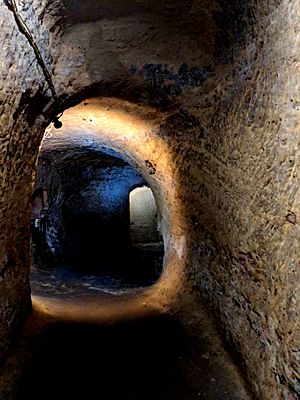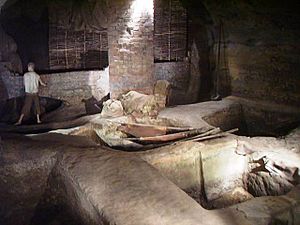City of Caves facts for kids
 |
|
 |
|
| Established | 2004 |
|---|---|
| Location | Broadmarsh Shopping Centre, Nottingham, United Kingdom |
City of Caves is a cool place to visit in Nottingham, England. It's built around a network of caves carved into soft sandstone. Over hundreds of years, these caves have been used for many things. They were once a place to make leather, cellars for pubs, and even air raid shelters during wartime.
These caves are so important that Historic England has listed them as a special historic site. They were originally known as Caves at Drury Hill. This was the name of the old street above them. That street was later removed to build the Broadmarsh Shopping Centre. The name City of Caves makes sense because Nottingham has hundreds of man-made caves. People have used these caves for over a thousand years!
You used to enter the City of Caves from the Broadmarsh Shopping Centre. Now, you can get in from Garner's Hill because of building work. This attraction is part of the National Justice Museum. The Egalitarian Trust has managed it since it opened in 2004.
Contents
Discovering Nottingham's Ancient Caves
A Look Back in Time
Nottingham is built on soft sandstone. This rock is easy to dig with simple tools. This is how people created many artificial cave homes. An old writer named Asser even called Nottingham Tig Guocobauc. This means Place of Caves in an old language. He wrote this in 893!
Some of these caves are very old. Pottery found inside them shows they were used between 1270 and 1300. People lived in these caves until 1845. That's when a law stopped people from renting caves as homes for the poor. None of the caves are natural. People dug them all out of the sandstone. They used them as houses, storage cellars, and workplaces.
If a man is poor, he can go to Nottingham with simple tools. He can dig a hole or burrow for his family.
—Anon 1870 (simplified)
As of 2018, over 800 caves in Nottingham have been recorded. About 200 of these were only found again after 2016. This was thanks to research by the city's archaeologist, Scott Lomax.
Saving the Caves
Building the Broadmarsh Shopping Centre started in the late 1960s. At first, there were plans to fill the caves with concrete. This made many people upset. The public wanted the caves saved. So, the Nottingham City Council studied the caves carefully. They worked with The Nottingham Historical Arts Society.
Because of this, the caves were protected as an ancient monument. The building plans were changed to save most of them. Volunteers helped clear out the caves. They were from the 2418 Sherwood Squadron Air Training Corps and Rushcliffe School. The caves then opened for public tours in 1978.
Caves Through the Ages
Medieval Tannery
Two caves here were once an underground tannery. This is where animal skins were turned into leather. It's the only known underground tannery in Britain! The Pillar Cave was first dug around 1250. It was later filled in by a rockfall. It was cleared again around 1500 to be part of the tannery. It had round pits for barrels.
Another cave was also dug with rectangular clay-lined pits. These pits were small. This means they probably processed sheep or goat skins. They didn't use cowhides, which are much larger. There was an opening to the River Leen. Here, workers would wash the skins.
Drury Hill Homes
The basement walls you see today are all that's left of Drury Hill. This was once a rich area in medieval times. But by the 1800s, it had become a very poor area. Many families lived in single-room basements. These places were very crowded. They also had poor sanitation. This meant people often got sick.
Air-Raid Shelter
Some of the caves were connected and made bigger. They became one of 86 public air raid shelters in Nottingham. These shelters protected people during the Second World War. By February 1941, they were ready for use. There was a very bad bombing on May 8, 1941. The tour at City of Caves shows what this was like. Holes were also dug here to get sand. This sand was used to fill sandbags. Sandbags helped protect the city from bombs.


